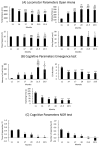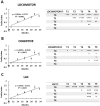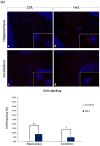Hericium erinaceus Improves Recognition Memory and Induces Hippocampal and Cerebellar Neurogenesis in Frail Mice during Aging
- PMID: 30934760
- PMCID: PMC6521003
- DOI: 10.3390/nu11040715
Hericium erinaceus Improves Recognition Memory and Induces Hippocampal and Cerebellar Neurogenesis in Frail Mice during Aging
Abstract
Frailty is a geriatric syndrome associated with both locomotor and cognitive decline, implicated in both poor quality of life and negative health outcomes. One central question surrounding frailty is whether phenotypic frailty is associated with the cognitive impairment during aging. Using spontaneous behavioral tests and by studying the dynamic change during aging, we demonstrated that the two form of vulnerability, locomotor and recognition memory decline, develop in parallel and therefore, integration of the motoric and cognitive evaluations are imperative. We developed an integrated frailty index based on both phenotypic and recognition memory performances. Hericium erinaceus (H. erinaceus) is a medicinal mushroom that improves recognition memory in mice. By using HPLC-UV-ESI/MS analyses we obtained standardized amounts of erinacine A and hericenones C and D in H. erinaceus extracts, that were tested in our animal model of physiological aging. Two-month oral supplementation with H. erinaceus reversed the age-decline of recognition memory. Proliferating cell nuclear antigen (PCNA) and doublecortin (DCX) immunohistochemistry in the hippocampus and cerebellum in treated mice supported a positive effect of an H. erinaceus on neurogenesis in frail mice.
Keywords: Hericium erinaceus; aging; cognitive decline; erinacines; hericenones; medicinal mushrooms supplementation; neurogenesis; phenotypic frailty.
Conflict of interest statement
The authors declare no conflict of interest.
Figures










References
-
- Hogan D.B., Mackinght C., Bergman H. Models, definitions, and criteria of Frailty. Aging Clin. Exp. Res. 2003;15:1–29. - PubMed
-
- Ferrucci L., Cavazzini C., Corsi A., Bartali B., Russo C.R., Lauretani F., Ferrucci L., Cavazzini C., Corsi A.M., Bartali B., et al. Biomarkers of frailty in older persons. J. Endocrinol. Investig. 2002;25:10–15. - PubMed
-
- Taffet G.E. Geriatric Medicine. Springer; New York, NY, USA: 2003. Physiology of aging; pp. 27–35.
MeSH terms
Substances
LinkOut - more resources
Full Text Sources
Miscellaneous

